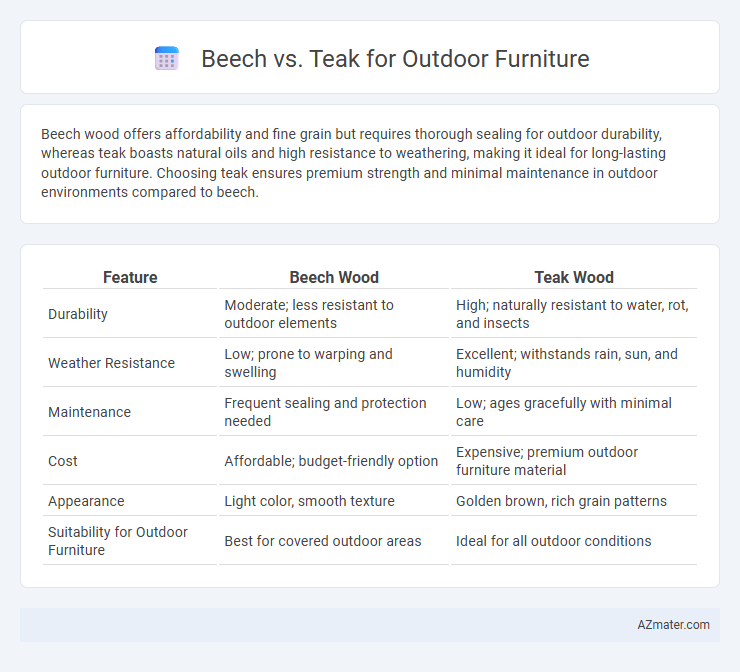Beech wood offers affordability and fine grain but requires thorough sealing for outdoor durability, whereas teak boasts natural oils and high resistance to weathering, making it ideal for long-lasting outdoor furniture. Choosing teak ensures premium strength and minimal maintenance in outdoor environments compared to beech.
Table of Comparison
| Feature | Beech Wood | Teak Wood |
|---|---|---|
| Durability | Moderate; less resistant to outdoor elements | High; naturally resistant to water, rot, and insects |
| Weather Resistance | Low; prone to warping and swelling | Excellent; withstands rain, sun, and humidity |
| Maintenance | Frequent sealing and protection needed | Low; ages gracefully with minimal care |
| Cost | Affordable; budget-friendly option | Expensive; premium outdoor furniture material |
| Appearance | Light color, smooth texture | Golden brown, rich grain patterns |
| Suitability for Outdoor Furniture | Best for covered outdoor areas | Ideal for all outdoor conditions |
Introduction to Beech and Teak Wood
Beech wood is a dense, hard hardwood known for its fine, uniform texture and pale cream color, making it popular for indoor furniture but less ideal for outdoor use due to its lower natural resistance to moisture and insects. Teak wood, sourced primarily from Southeast Asia, is highly valued in outdoor furniture for its exceptional durability, natural oils, and resistance to weather, decay, and pests, ensuring longevity even in harsh conditions. Both woods offer distinct aesthetics and properties, but teak's superior weather resistance makes it the preferred choice for outdoor applications.
Key Differences Between Beech and Teak
Beech wood is a dense hardwood with a fine, tight grain that tends to absorb moisture, making it less ideal for prolonged outdoor use without proper treatment, whereas teak contains natural oils that provide exceptional resistance to water, decay, and insects, enhancing its durability in outdoor furniture. Teak's golden-brown color naturally weathers to a silvery-gray patina over time, unlike beech, which can fade and warp if exposed to the elements. Maintenance requirements for beech include regular sealing and finishing, while teak demands minimal upkeep to retain its strength and appearance under outdoor conditions.
Durability in Outdoor Environments
Teak is renowned for its exceptional durability in outdoor environments due to its high natural oil content, which provides resistance to water, pests, and decay. Beech, while strong and hard, lacks these natural oils, making it more susceptible to moisture damage and requiring regular treatment to maintain longevity outdoors. For outdoor furniture, teak offers superior resilience and lower maintenance compared to beech, ensuring longer-lasting performance in harsh weather conditions.
Resistance to Weather and Moisture
Teak wood exhibits exceptional resistance to weather and moisture due to its natural oils and dense grain, making it highly durable for outdoor furniture in various climates. Beech wood, however, is less resistant to water and tends to absorb moisture, leading to swelling, warping, and decay over time if not properly treated or sealed. For long-lasting outdoor use, teak is preferred because it withstands rain, humidity, and temperature fluctuations without significant damage.
Maintenance Requirements
Beech requires regular sealing and protection from moisture to prevent warping and decay, making maintenance more intensive for outdoor furniture. Teak naturally contains oils that resist water, insects, and rot, allowing it to withstand outdoor conditions with minimal maintenance. Over time, teak develops a desirable silver-gray patina if left untreated, reducing the need for frequent upkeep compared to beech.
Appearance and Color Over Time
Beech wood features a light, creamy color with a fine, uniform grain that weathers to a warm honey tone, but it tends to fade and gray when exposed to outdoor elements without proper treatment. Teak boasts a rich golden-brown hue with natural oils that preserve its color and grain, developing a desirable silvery-gray patina over time while maintaining durability. The natural oils in teak offer superior resistance to moisture and UV damage, ensuring its appearance remains more consistent and visually appealing for outdoor furniture exposed to sun and rain.
Cost Comparison: Beech vs Teak
Beech outdoor furniture is generally more affordable than teak, with prices often ranging from 30% to 50% lower due to its faster growth rate and widespread availability. Teak commands a premium price because of its natural oils, exceptional durability, and resistance to weather and pests, which reduce maintenance costs over time. While beech may require regular sealing and protection to prevent weather damage, teak's long-term investment typically offsets its higher upfront cost.
Sustainability and Environmental Impact
Beech wood, sourced primarily from temperate European forests, is considered moderately sustainable due to its faster growth rate and the availability of FSC-certified options, but it tends to require more chemical treatment to withstand outdoor conditions. Teak is highly valued for outdoor furniture due to its natural oils that resist water and pests, often harvested from well-managed plantations in Southeast Asia, though illegal logging remains a concern affecting its environmental impact. Choosing FSC-certified teak or beech can significantly reduce ecological footprints, making certification a crucial factor in sustainable outdoor furniture selection.
Best Uses for Each Wood Type
Beech wood offers exceptional strength and a smooth finish, making it ideal for indoor or covered outdoor furniture where minimal exposure to moisture occurs. Teak wood boasts natural oils providing superior resistance to water, insects, and decay, making it the preferred choice for exposed outdoor furniture such as garden sets, patio chairs, and decking. Understanding the moisture resistance and durability of teak versus the solid, fine grain of beech helps determine the best application for long-lasting outdoor use.
Final Recommendation: Which Wood to Choose for Outdoor Furniture
Teak wood is highly recommended for outdoor furniture due to its natural oils and dense grain, which provide superior resistance to weather, insects, and decay compared to beech. Although beech is affordable and sturdy for indoor uses, it lacks durability and moisture resistance, making it less suitable for prolonged outdoor exposure. For long-lasting, low-maintenance outdoor furniture, teak's longevity and weatherproof qualities make it the optimal choice.

Infographic: Beech vs Teak for Outdoor Furniture
 azmater.com
azmater.com